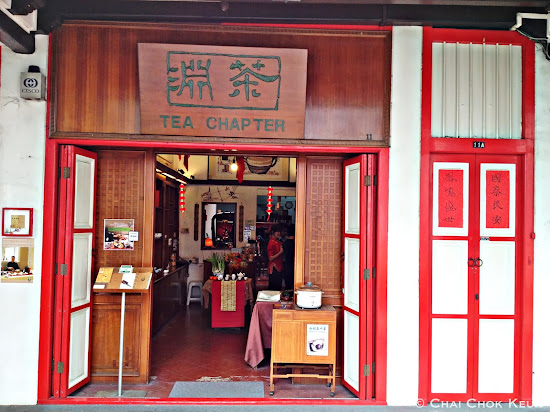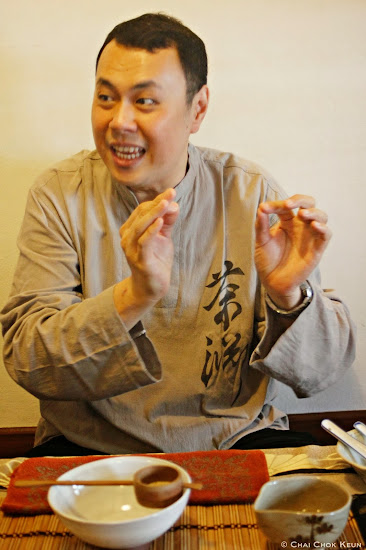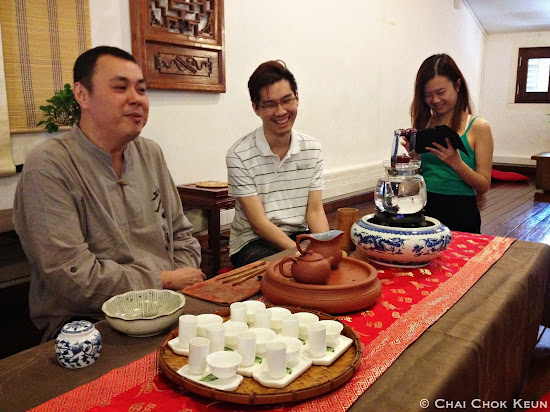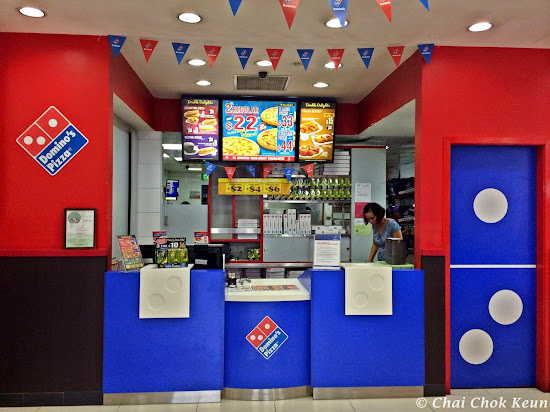Tea Pairing Session With Master Kang at Tea Chapter Singapore
Established since 1 Oct 1989, Tea Chapter 茶渊 is one of the few remaining, and largest Tea House in Singapore. It has housed countless of guests all over the world, including prominent visitors like Queen Elizabeth II, former Singapore President, S.R. Nathan, and current President, Dr. Tony Tan, and many others.
The Tea House has various types of seats, including Queen's Corner, Oriental Style, Korean Style & Japanese Style, Air Well Corner, etc, which different surcharge may applies.
While I do love to drink Chinese Tea, I do not really know much in depth about the Chinese Tea. Therefore having the chance to attend this Tea Pairing Session with Master Patrick Kang at Tea Chapter has been a very valuable session for me.
In the session, we get to learn about the history of Tea and how it was discovered by the Chinese Emperor, Shen Nong (神农), whom love his water to be boiled before drinking, and somehow one day some leaves from the tea plant unexpectedly fell into the water, and went unnoticed and the boiled water with tea leaves was presented to him. Having tried this refreshing drink, this is how the tea comes about.
We also get to learn the various classification of Chinese Tea, which includes Black Tea (黑茶), Oolong Tea (which is also known as the Blue Tea) (乌龙茶,又或蓝茶/青茶), Green Tea (绿茶) , Yellow Tea (黄茶), White Tea (白茶) , and Floral Tea(花茶). But never did I know, the existence of the Blue Tea classification prior to the session.
Tea drinking isn't as simple as what most people thought, using boiling the water to brew a cup a tea. The choice of water and the temperature of boiling water will impact the taste of the tea. And the quality of tea leaves isn't just about picking the most expensive of tea leaves. It is also very much dependant on the ambience of the surrounding, and the disposition of one.
Longjing Tea (龙井茶)was paired with apricot(杏), fig (无花果), chestnut(栗子). So what should be the sequence of eating these snacks, do you have any idea? It should be started with the one with the mildest taste, which is chestnut and end with the one with the strong taste - apricot.
When pouring the tea, it is usually 70% filled only, due to the Chinese Sayings, “茶倒七分满,人情留三分” .
The Huanjin Gui was served to Queen Elizabeth II during her visit to Tea Chapter in 1989, as she belongs to the Imperial Family, so their in house Huanjin Gui was renamed as Imperial Huangjin Gui after that.
It is important to use the tea leaves holder to dig out the tea leaves than using your hands, to avoid contaminating the tea leaves. The brewed Huangjin Gui was first poured to the snifer cup (闻香杯) , which we in turned pour into the tea to tasting teacups (品茗杯) , and then hold the empty snifer cup in our palm, rub it, and smell the tea aroma.
Tea Chapter's signature Tea Leaf Egg/Cha Ye Dan (茶叶蛋)was paired with the Imperial Huangjin Gui. Despite the lack of herbal ingredients, Tea Chapter's Tea Leaf Eggs are no less tasty than those Herbal Tea Leaf Eggs in the market.
For those who do not fancy the fragrance of pandan leaves, or find it too strong covering the taste of the Jasmine Tea, it is recommended to omit putting the small slice of pandan leaves into the teacup. This was paired with Matcha Ruan Gao (绿茶软糕) which was earlier prepared by Master Kang in the morning.
We had a chance to see Master Kang's demonstration on the making of the Matcha Ruan Gao (绿茶软糕)and hands on towards the final part, and get to bring some home. During the demonstration, Master Kang also shared about some other functions of tea, e.g. for food making and for medical purposes.
At the end of the pairing session, other than getting to taste a variety of the different teas with some matching tea snacks, we get to bring back some knowledge on the history of Chinese tea, and tea appreciation. I love that the session was held among a small group of not exceeding 8 person, which is cozy enough to have 1-1 interaction with the Tea Master.
Before we call it a day, we decided to make a tour around the tea shop of Tea Chapter where many varieties of teas and tea ware are available for sale.
They even have Chinese New Year Goodies! Almond Biscuits 杏仁饼 (S$18.00) and Pineapple Tarts 凤梨酥 ($20.00).
If you would love to pick up more on tea culture, or find a cozy venue for an idyllic chat with your friends, a place for a spiritual peace and escape from your stress, or a place where you can spend your lazy afternoon during weekends, you may want to check out Tea Chapter.
Tea Chapter Singapore
9A & 11 Neil Road
Singapore 088808
Tel: 65 6226 1175
Opening Hours: 10:30 - 22:30
Official Website: http://teachapter.com/
Facebook page: https://www.facebook.com/TeaChapter
The Tea House has various types of seats, including Queen's Corner, Oriental Style, Korean Style & Japanese Style, Air Well Corner, etc, which different surcharge may applies.
While I do love to drink Chinese Tea, I do not really know much in depth about the Chinese Tea. Therefore having the chance to attend this Tea Pairing Session with Master Patrick Kang at Tea Chapter has been a very valuable session for me.
In the session, we get to learn about the history of Tea and how it was discovered by the Chinese Emperor, Shen Nong (神农), whom love his water to be boiled before drinking, and somehow one day some leaves from the tea plant unexpectedly fell into the water, and went unnoticed and the boiled water with tea leaves was presented to him. Having tried this refreshing drink, this is how the tea comes about.
We also get to learn the various classification of Chinese Tea, which includes Black Tea (黑茶), Oolong Tea (which is also known as the Blue Tea) (乌龙茶,又或蓝茶/青茶), Green Tea (绿茶) , Yellow Tea (黄茶), White Tea (白茶) , and Floral Tea(花茶). But never did I know, the existence of the Blue Tea classification prior to the session.
Tea drinking isn't as simple as what most people thought, using boiling the water to brew a cup a tea. The choice of water and the temperature of boiling water will impact the taste of the tea. And the quality of tea leaves isn't just about picking the most expensive of tea leaves. It is also very much dependant on the ambience of the surrounding, and the disposition of one.
First Pairing: Longjing Tea (龙井茶)
Longjing Tea (龙井茶)was paired with apricot(杏), fig (无花果), chestnut(栗子). So what should be the sequence of eating these snacks, do you have any idea? It should be started with the one with the mildest taste, which is chestnut and end with the one with the strong taste - apricot.
When pouring the tea, it is usually 70% filled only, due to the Chinese Sayings, “茶倒七分满,人情留三分” .
Second Pairing: Huangjin Gui (黄金桂)
Master Kang went through with us the tedious steps of warming the tea set and the come about of their in house Imperial Huangjin Gui (御用黄金桂). We were also taught the different way of holding the tea cup by both male and females, the correct way to hold the teapot cover, as well as the various type of Zisha Teapots / Purple Sand Pots(紫砂壶).The Huanjin Gui was served to Queen Elizabeth II during her visit to Tea Chapter in 1989, as she belongs to the Imperial Family, so their in house Huanjin Gui was renamed as Imperial Huangjin Gui after that.
It is important to use the tea leaves holder to dig out the tea leaves than using your hands, to avoid contaminating the tea leaves. The brewed Huangjin Gui was first poured to the snifer cup (闻香杯) , which we in turned pour into the tea to tasting teacups (品茗杯) , and then hold the empty snifer cup in our palm, rub it, and smell the tea aroma.
Tea Chapter's signature Tea Leaf Egg/Cha Ye Dan (茶叶蛋)was paired with the Imperial Huangjin Gui. Despite the lack of herbal ingredients, Tea Chapter's Tea Leaf Eggs are no less tasty than those Herbal Tea Leaf Eggs in the market.
Third Pairing: Pandan Jasmine Tea (香兰茉莉花茶)
The last pairing, is something different from the rest, whereby Pandan leaves are added to the Jasmine Tea for an additional aroma.We had a chance to see Master Kang's demonstration on the making of the Matcha Ruan Gao (绿茶软糕)and hands on towards the final part, and get to bring some home. During the demonstration, Master Kang also shared about some other functions of tea, e.g. for food making and for medical purposes.
Before we call it a day, we decided to make a tour around the tea shop of Tea Chapter where many varieties of teas and tea ware are available for sale.
They even have Chinese New Year Goodies! Almond Biscuits 杏仁饼 (S$18.00) and Pineapple Tarts 凤梨酥 ($20.00).
If you would love to pick up more on tea culture, or find a cozy venue for an idyllic chat with your friends, a place for a spiritual peace and escape from your stress, or a place where you can spend your lazy afternoon during weekends, you may want to check out Tea Chapter.
Tea Chapter Singapore
9A & 11 Neil Road
Singapore 088808
Tel: 65 6226 1175
Opening Hours: 10:30 - 22:30
Official Website: http://teachapter.com/
Facebook page: https://www.facebook.com/TeaChapter











.JPG)














Comments
Post a Comment